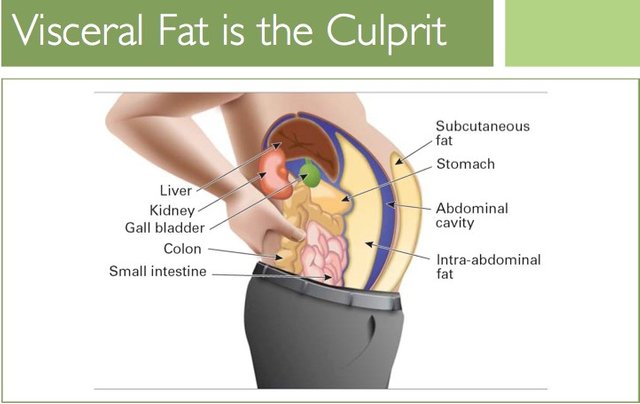Visceral fat is a form of fat found in the abdominal cavity, adjacent to various essential organs, and is linked to an increased risk of cardiovascular disease, including heart attacks and atherosclerosis, because it can be deposited in the heart.
This type of fat accumulates mostly as a result of bad lifestyle behaviors, particularly a diet high in sugar, fat, and processed foods, as well as a lack of physical activity.
As a result, it's critical to adopt healthy living behaviors that help prevent the buildup of visceral fat and, as a result, lower health risks. It's critical to have a low-fat, low-sugar diet and exercise regularly aerobic physical activity. regular way.
Visceral Fat Risks

Large amounts of visceral fat can impair the functioning of many organs, as fat can accumulate in organs such as the liver, stomach, colon, and heart, and favor the development of insulin resistance, which increases the risk of diabetes.
As a result, the presence of visceral fat can have health implications because it increases the likelihood of acquiring diseases such as:
- Cardiovascular diseases such as heart attack and atherosclerosis;
- Type 2 diabetes;
- Liver failure;
- Gastrointestinal changes;
- High blood pressure.
Therefore, it is essential to visit a general practitioner or cardiologist, in addition to a nutritionist, who is in charge of performing an exam to determine the levels of visceral fat, the possible reasons, and therefore, suggest measures to help eradicate visceral fat and avoid dangers.
Main causes
The accumulation of visceral fat is mostly caused by bad lifestyle behaviors such as sedentary behavior and a high-fat, high-sugar diet. As a result of the poor diet and the lack of use of fat and carbs as a source of energy, fat and carbohydrates likely accumulate in the body.
Furthermore, excessive amounts of visceral fat may be linked to poor sleep quality and elevated cortisol levels, which can lead to increased weight and waist circumference due to fluid retention and fat redistribution in the body. and a rise in blood sugar levels as a result of the liver's stimulus to make glucose.
How to lose visceral fat
It is critical to adopt good health habits, such as daily physical activity and a low-calorie, sugar-free diet, by the nutritionist's recommendations, to efficiently eradicate visceral fat. As a result, it is feasible to encourage the removal of visceral fat and prevent the fat formation in the organs.
2 Easy Steps to Get Rid of Visceral Belly Fat (the DEADLIEST type)
1. Food
.jpg)
To get rid of visceral fat, you should eat a low-calorie, low-sugar diet, as this will prevent new fat from accumulating in the body. This diet should be recommended by a nutritionist based on the amount of visceral fat accumulated and the risk of disease development. As a result, below are some foods that can be ingested daily:
- Apple, pear, strawberry, kiwi, pineapple;
- Chard, spinach, lettuce, kale, arugula;
- Pumpkin, celery, zucchini, cucumber, beetroot, tomato, onion;
- Fish such as hake, halibut, sea bass, bream (You may be buying "toxic fish" at the supermarket );
- Chicken or turkey meat (Never grill meat unless you first do THIS );
- Almonds, walnuts, hazelnuts, chia seeds, flaxseed, pumpkin, or sunflower.
In addition, thermogenic foods such as cinnamon, coffee, ginger, or green tea, for example, can be added to the diet to help speed up metabolism and facilitate fat loss.
See Too :
- 3 Ways to Make Super-Healthy Coffee
- What's the connection between broccoli and belly fat? (unusual fat-fighters)
- 1 Distinctive spice that combats abdominal fat
- What's the matter with red wine and your gut? (study results)
- To get a better night's sleep, drink 2 hours before bedtime (5 more tips for insomnia)
2. Exercises
.jpg)
Exercise is essential in the removal of visceral fat since it aids in the stimulation of metabolism and, as a result, fat burning. However, aerobic workouts, particularly those that help increase physical fitness, support cardiovascular health, and stimulate the development of muscle mass at the same time, are essential for effectively eliminating visceral fat.
Running, swimming, cycling, and jumping rope are examples of aerobics, as are workouts with a higher intensity such as HIIT, Crossfit, and functional circuits. It is recommended that you exercise for at least 30 minutes each day. Check out 1 Uncommon tip to improve the effectiveness of any fitness regimen
How do you calculate visceral fat
.jpg)
Before beginning the process of visceral fat loss, it is critical to analyze the quantity of body fat, which may be done with computed tomography, MRI, ultrasound, or by measuring the abdominal circumference, which for males should not exceed 94 cm and for women should not exceed 80 cm.
There is more stored fat and a higher chance of developing issues, notably cardiovascular diseases when the waist circumference is greater than these values.
During the consultation, the doctor or nutritionist can also perform the bioimpedance exam, which allows checking the person's overall body composition, including the amount of accumulated fat in the body, in addition to the exams and measurement of the waist-hip ratio.
Is it possible to get rid of visceral fat with liposuction?
Despite the fact that it is a surgery that removes belly fat, liposuction only removes the fat that is under the skin and does not remove the visceral fat that is deeper in the abdomen, along with the organs.
Because there are fewer fat cells under the skin and excess food is stored in visceral fat, the amount of visceral fat may even increase after liposuction in many cases if the patient does not engage in regular physical activity.
Source: Your Health